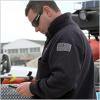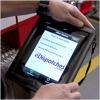Case Studies
LifeProof Heats Up Device Protection for Firefighters
“The department members stayed connected with each other and their families using mobile technology, and they relied on LifeProof protection to keep their smartphones in working order.”
The volunteer firefighters of Seaside Heights, N.J., often risk their lives to protect their barrier island community from hazards on land and in the sea. In less than a year, this proud department not only weathered the near decimation of their borough by Hurricane Sandy, they also battled one of the area’s largest blazes, which tore through the historic boardwalk. Through all of this chaos, the department members stayed connected with each other and their families using mobile technology, and they relied on LifeProof protection to keep their smartphones in working order.
Seaside Heights has a population hovering around 3,000 residents; however, during the summer weekends, the long stretches of beach can attract more than 50,000 visitors. Dedicated to protecting this community, the Seaside Heights Fire Department is an all-volunteer organization that tackles much more than its name implies.
“The borough of Seaside Heights is on a barrier island,” explained Brian Dardis, a first lieutenant with the department. “We’re on a piece of land that’s about 20 miles long from tip to tip and only about a half a mile wide at the widest. During high tides with rain, we get flooding in town. Being one of five fire departments that cover this whole island, it’s inevitable that you’re going to come into contact with water every day.”
Hurricane Sandy
While the department is well trained for water rescue, a task they perform as a regular duty, Hurricane Sandy was of a magnitude unlike any other storm that had battered this area. It wreaked havoc along the East Coast during the final days of October 2012.
“Hurricane Sandy was a huge event,” Dardis said. “We started an evacuation process and went door to door, to every house in the community, to try to get the people to evacuate the island. No one believed that a storm of that magnitude was ever going to hit. We live through nor’easters constantly down here. This storm turned out to be historic.”
The volunteers that could reach the station held their ground through the storm, mobilizing immediately after the worst had passed to rescue those that had not evacuated. The island was completely flooded, with rushing waters that were chest-high in some areas. Rescues often necessitated tying the responding firefighters to the large military vehicles they were using to ensure they were not swept away. The firehouse became an evacuation center, housing as many as 100 members of the community during and immediately after the storm.
“Out on calls, we would pick up a load of people that were just out on the streets,” recalled Tim Farrell, water rescue captain for the department. “We’d hear them in the darkness and the wind. It was nonstop that whole night and the next day.”
With no power or utilities and downed communication systems, the firefighters relied on their smartphones to receive distress calls and stay in touch. The department adopted mobile technology as a means activating its volunteers several years ago, replacing an expensive and clunky pager system. Now, firefighters receive calls along with detailed information pertaining to location and conditions to their personal devices.
“I wore a wet suit with the lifejacket on with my phone attached to it,” Farrell said. “That was my only source of communication back to my chief here and back to my loved ones who were off the island to let them know I was okay. I’d call them a couple of times per night.”
“A lot of times, the communication comes from our phones now, rather than our radios. It’s key for us to have our phones on us and to protect it at the same time. LifeProof allows us to do that.”
Fire chief Louis Nardone relied almost solely on mobile technology to activate his team during the storm, manually dispatching calls. He was confident that these devices would remain a consistent point of contact due to the protection provided by LifeProof cases.
“A lot of times, the communication comes from our phones now, rather than our radios,” he said. “It’s key for us to have our phones on us and to protect it at the same time. LifeProof allows us to do that.”
LifeProof is dedicated to freedom – allowing mobile technology users to go anywhere and do anything without worry for their devices. The cases offer protection from the hazards most likely to damage or destroy a device without compromising function:
- Fully submersible and completely waterproof at depths of 6.6 feet for one hour
- Withstand drops of 6.6 feet
- Totally sealed from dirt and dust
- Complete access to all buttons, ports, functions and features
“Using smartphones has saved the department money as well as precious minutes.”
Smartphones proved useful yet again when a major fire tore through the boardwalk. Less than a year after Hurricane Sandy, Seaside was hit with yet another tragedy when an electrical issue lit up a shop on the historic boardwalk in neighboring Seaside Park. Heavy winds created a perfect storm for the fire as it consumed blocks of businesses along the Seaside Heights boardwalk. In total, more than 400 firefighters responded to fight the blaze for more than 10 hours, with hot-spot mitigation continuing for the following week.
Lieutenant Dardis recalls battling at one end of the blaze and keeping in touch with fellow firefighters at the opposite end using his smartphone. This connection helped him and other officers assess the situation as the wind continued to factor into the response.
Through epic storms, historic fires and the challenges of daily duty, mobile technology has become department protocol in Seaside Heights. Using smartphones has saved the department money as well as precious minutes.
“I use my phone for mapping, hydrant locations, if a call comes in, it comes right to my smartphone,” Farrell said. “It’s quicker than the pager system, which is great. Minutes count when saving lives. The technology is out there that can give us the extra couple minutes that we need.”
Nardone pointed to the fact that pagers were often lost, damaged or just left behind, but smartphones go everywhere with their users – including in the water. After losing two of his phones to water damage, he sought a solution to preserve this connection for his team.
“I was looking for something to protect the phone because every time we had a water call, you’d be out at the beach and have your phone. When a call goes out, you don’t think about anything else except getting out there,” he said. “I tested a couple of different cases, but they just didn’t feel right. I wouldn’t go to anything else because there’s no substitute for it. It’s fully functional and it keeps the phone in a pristine condition.”
About LifeProof
LifeProof’s company mantra is Freedom; LifeProof designs, manufactures and markets an entirely new category of products designed to give people more freedom from environmental constraints. Based in San Diego, LifeProof offers elegant and protective cases for Smartphones and Tablet PCs that enable full functionality and interactivity under any condition encountered in daily life. The registered brand name ‘LifeProof’ is inspired by the protection and fully functional convenient operation of the device in water, mud, dirt, or snow. For more information, visit www.lifeproof.com.

